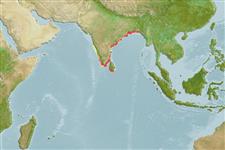Environment: milieu / climate zone / depth range / distribution range
Ecología
marino; salobre; oceanodromo (Ref. 51243); rango de profundidad 0 - 50 m (Ref. 189). Tropical; 25°N - 5°N, 71°E - 94°E (Ref. 189)
Indian Ocean: eastern coasts of India; possibly also Myanmar.
Tamaño / Peso / Age
Maturity: Lm ? range ? - ? cm
Max length : 15.5 cm SL macho / no sexado; (Ref. 189)
Espinas dorsales (total): 0; Espinas anales 0; Radios blandos anales: 38 - 44. Belly with 26 or 27 keeled scutes from isthmus to anus. Tip of snout a little above level of eye center. Maxilla moderate, projecting at most to halfway to pectoral fin base; first supra-maxilla small; angle of mouth rather oblique, teeth of lower jaw slightly enlarged. An indistinct dark blotch behind upper part of gill opening and a faint dark line along back.
Presumably schooling, occurring mostly inshore and entering estuaries and also Lake Chilka in India, thus able to tolerate lowered salinities. More data needed based on correct identifications. If this is the species being referred to in Ref. 6841, then the young feeds on surface plankton, chiefly on prawn larvae, but also small fishes (e.g. Stolephorus) and cypris. Apparently common.
Life cycle and mating behavior
Madurez | Reproducción | Puesta | Huevos | Fecundidad | Larva
Whitehead, P.J.P., G.J. Nelson and T. Wongratana, 1988. FAO Species Catalogue. Vol. 7. Clupeoid fishes of the world (Suborder Clupeoidei). An annotated and illustrated catalogue of the herrings, sardines, pilchards, sprats, shads, anchovies and wolf-herrings. FAO Fish. Synop. 125(7/2):305-579. Rome: FAO. (Ref. 189)
IUCN Red List Status (Ref. 130435)
Threat to humans
Harmless
Human uses
Pesquerías: escaso valor comercial
Más información
Nombres comunesSinónimosMetabolismoDespredadoresEcotoxicologíaReproducciónMadurezPuestaAgregación para la puestaFecundidadHuevosEgg development
ReferenciasAcuiculturaPerfil de acuiculturaRazasGenéticaElectrophoresesheritabilidadEnfermedadesProcesamientoNutrientsMass conversion
ColaboradoresImágenesStamps, Coins Misc.SonidosCiguateraVelocidadTipo de nataciónSuperficie branquialOtolitosCerebrosVisión
Herramientas
Special reports
Download XML
Fuentes de Internet
Estimates based on models
Preferred temperature (Ref.
123201): 27.5 - 28.6, mean 27.9 °C (based on 54 cells).
Phylogenetic diversity index (Ref.
82804): PD
50 = 0.5000 [Uniqueness, from 0.5 = low to 2.0 = high].
Bayesian length-weight: a=0.00339 (0.00179 - 0.00640), b=3.08 (2.92 - 3.24), in cm total length, based on LWR estimates for this species & Genus-body shape (Ref.
93245).
Nivel trófico (Ref.
69278): 3.5 ±0.50 se; based on food items.
Resiliencia (Ref.
120179): Alto, población duplicada en un tiempo mínimo inferior a 15 meses (Preliminary K or Fecundity.).
Fishing Vulnerability (Ref.
59153): Low vulnerability (10 of 100).
